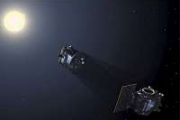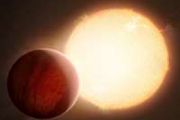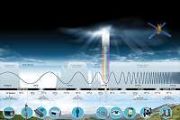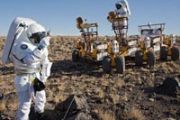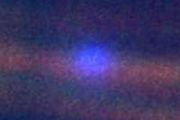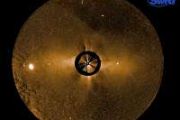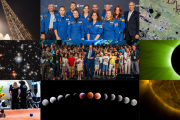
Copernical Team
Long March 2C rocket carrying four satellites launched
 China launched a Long March 2C carrier rocket on Monday morning at the Xichang Satellite Launch Center in Sichuan province to place four satellites into space.
The rocket blasted off at 8:19 am and deployed three Yaogan 30-series remote-sensing satellites as well as a micro communication satellite into their orbits, said the China Aerospace Science and Technology Corp, the country's leadin
China launched a Long March 2C carrier rocket on Monday morning at the Xichang Satellite Launch Center in Sichuan province to place four satellites into space.
The rocket blasted off at 8:19 am and deployed three Yaogan 30-series remote-sensing satellites as well as a micro communication satellite into their orbits, said the China Aerospace Science and Technology Corp, the country's leadin China's experimental space plane aces test flight
 China's reusable aerospace plane, which was tested on Friday, offers great potential in a wide range of businesses, according to industry observers.
"It will be able to do many different things: space tourism, transporting astronauts, satellite deployment, cargo transportation and emergency rescues," said Wang Yanan, editor-in-chief of Aerospace Knowledge magazine.
"Compared to rocke
China's reusable aerospace plane, which was tested on Friday, offers great potential in a wide range of businesses, according to industry observers.
"It will be able to do many different things: space tourism, transporting astronauts, satellite deployment, cargo transportation and emergency rescues," said Wang Yanan, editor-in-chief of Aerospace Knowledge magazine.
"Compared to rocke With the HUMANS project, a message that space is for everyone
 When the Voyager 1 and Voyager 2 spacecraft launched in 1977, they each carried a Golden Record, a special project spearheaded by astrophysicist Carl Sagan, in addition to the scientific instruments necessary for their mission to explore the outer reaches of our solar system. Part time capsule, part symbolic ambassador of goodwill, the Golden Record comprises sounds, images, music, and greetings
When the Voyager 1 and Voyager 2 spacecraft launched in 1977, they each carried a Golden Record, a special project spearheaded by astrophysicist Carl Sagan, in addition to the scientific instruments necessary for their mission to explore the outer reaches of our solar system. Part time capsule, part symbolic ambassador of goodwill, the Golden Record comprises sounds, images, music, and greetings Jeff Bezos wants flight to expand 'new frontiers' in space
 Jeff Bezos, the man who made e-commerce the "economy's new frontier," plans to fly into space Tuesday in an effort to make tourism far above the Earth the new frontier.
Time magazine recognized Bezos as "Person of the Year" in 1999 for his founding of the Amazon retail website, saying, "Some people must be genetically predisposed to explore the frontiers."
Bezos has grown into on
Jeff Bezos, the man who made e-commerce the "economy's new frontier," plans to fly into space Tuesday in an effort to make tourism far above the Earth the new frontier.
Time magazine recognized Bezos as "Person of the Year" in 1999 for his founding of the Amazon retail website, saying, "Some people must be genetically predisposed to explore the frontiers."
Bezos has grown into on Umbra awarded $950M IDIQ contract following Space-X launch
 Umbra has been awarded a $950,000,000 ceiling indefinite-delivery/indefinite-quantity (IDIQ) contract for the maturation, demonstration, and proliferation of capability across platforms and domains, leveraging open systems design, modern software, and algorithm development to enable Joint All Domain Command and Control (JADC2).
This contract is part of a multi-award, multi-level security e
Umbra has been awarded a $950,000,000 ceiling indefinite-delivery/indefinite-quantity (IDIQ) contract for the maturation, demonstration, and proliferation of capability across platforms and domains, leveraging open systems design, modern software, and algorithm development to enable Joint All Domain Command and Control (JADC2).
This contract is part of a multi-award, multi-level security e Air Force tasks Rhea Space Activity to build rapid-response Lunar comsats
 As U.S. operations in space steadily move further away from Earth orbit, the rapidly growing 'New Space' company Rhea Space Activity (RSA) is pleased to announce that it has been selected by the United States Air Force (USAF) for a Phase I, Small Business Innovation Research (SBIR) 2021 Space Force Pitch Day award to investigate a bi-modal, solar-thermal propulsion system that would provide rapi
As U.S. operations in space steadily move further away from Earth orbit, the rapidly growing 'New Space' company Rhea Space Activity (RSA) is pleased to announce that it has been selected by the United States Air Force (USAF) for a Phase I, Small Business Innovation Research (SBIR) 2021 Space Force Pitch Day award to investigate a bi-modal, solar-thermal propulsion system that would provide rapi ESA Highlights 2020: interactive format now available!

ESA Highlights 2020: interactive format now available!
ExoMars orbiter continues hunt for key signs of life on Mars

The ESA-Roscosmos Trace Gas Orbiter has set new upper limits on how much methane, ethane, ethylene and phosphine is in the martian atmosphere – four so-called ‘biomarker’ gases that are potential signs of life.
Tail without a comet: The dusty remains of Comet ATLAS

Freeze drying, oral health experiments make speedy return from space station aboard SpaceX Dragon

A suite of International Space Station scientific experiments soon journey back to Earth aboard the 22nd SpaceX commercial resupply services mission for NASA. Scientists on the ground look forward to having their experiments back within hours, an advantage that could provide better results. Dragon undocks from the space station July 7.
The combination of a spacecraft redesign allowing for faster unloading of research and the splashdown location near NASA's Kennedy Space Center in Florida makes it possible to return time-sensitive experiments to scientists much faster. In addition, Kennedy's Space Station Processing Facility is home to world-class laboratories offering tools and workspace to collect data and analyze samples.















